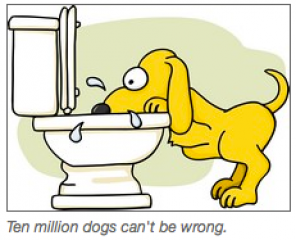Texas city using treated wastewater for drinking... - a toilet-to-tap reuse program -

s much of Texas grapples with lingering drought, a second city in the Lone Star State has begun reusing treated wastewater in a state-approved recycling process to bolster drinking supplies.
Wichita Falls, near the Oklahoma border, on Wednesday began reusing millions of gallons of water at the River Road Waste Treatment plant that's been purified to meet government drinking standards. The water is then sent by a 12-mile pipeline to the Cypress Water Treatment Plant for additional purification.
The Texas Commission on Environmental Quality approved Wichita Falls' proposal for a toilet-to-tap reuse program for up to six months.
The West Texas town of Big Spring, whose spring dried up decades ago, implemented an indirect potable reuse program — where effluent flows into another body of water before being treated — earlier this year. The water is then filtered through reverse osmosis. The city of Brownwood, about 80 miles south of Abilene, has approval for a project similar to Wichita Falls' to treat 1.5 million gallons of water daily, but it has not started doing so.
Wichita Falls is operating under a Stage 5 drought catastrophe, in which outdoor watering is banned and conservation is urged. Demand for city water has dropped 45 percent, according to City Manager Darron Leiker.
Still, the city's reservoirs are on a trajectory to run dry by August 2016, according to the Texas Water Development Board. The Wichita Falls area needs drinking water for about 150,000 people, and supplies from local reservoirs have plummeted from nearly 90 percent capacity before the drought began in late 2010 to about 20 percent capacity in late June.
"We can't conserve our way out of this," Leiker said.
The city's cloud-seeding experiments to stimulate rain have been unsuccessful. It's considering using a polymer product to coat the surface of its reservoirs to repress evaporation, though a recent field test proved disappointing.
The situation is fallout from Texas' driest year ever in 2011. Since then, when rain has fallen in the western half of the state, it didn't land into lakes' watersheds.
The drought is the second-worst in Texas after the 1950s Dust Bowl, according to the state's climatologist, John Nielsen-Gammon.
Read more -

s much of Texas grapples with lingering drought, a second city in the Lone Star State has begun reusing treated wastewater in a state-approved recycling process to bolster drinking supplies.
Wichita Falls, near the Oklahoma border, on Wednesday began reusing millions of gallons of water at the River Road Waste Treatment plant that's been purified to meet government drinking standards. The water is then sent by a 12-mile pipeline to the Cypress Water Treatment Plant for additional purification.
The Texas Commission on Environmental Quality approved Wichita Falls' proposal for a toilet-to-tap reuse program for up to six months.
The West Texas town of Big Spring, whose spring dried up decades ago, implemented an indirect potable reuse program — where effluent flows into another body of water before being treated — earlier this year. The water is then filtered through reverse osmosis. The city of Brownwood, about 80 miles south of Abilene, has approval for a project similar to Wichita Falls' to treat 1.5 million gallons of water daily, but it has not started doing so.
Wichita Falls is operating under a Stage 5 drought catastrophe, in which outdoor watering is banned and conservation is urged. Demand for city water has dropped 45 percent, according to City Manager Darron Leiker.
Still, the city's reservoirs are on a trajectory to run dry by August 2016, according to the Texas Water Development Board. The Wichita Falls area needs drinking water for about 150,000 people, and supplies from local reservoirs have plummeted from nearly 90 percent capacity before the drought began in late 2010 to about 20 percent capacity in late June.
"We can't conserve our way out of this," Leiker said.
The city's cloud-seeding experiments to stimulate rain have been unsuccessful. It's considering using a polymer product to coat the surface of its reservoirs to repress evaporation, though a recent field test proved disappointing.
The situation is fallout from Texas' driest year ever in 2011. Since then, when rain has fallen in the western half of the state, it didn't land into lakes' watersheds.
The drought is the second-worst in Texas after the 1950s Dust Bowl, according to the state's climatologist, John Nielsen-Gammon.
Read more -
http://news.yahoo.com/texas-city-using-treated-wastewater-drinking-200245424.html

No comments:
Post a Comment